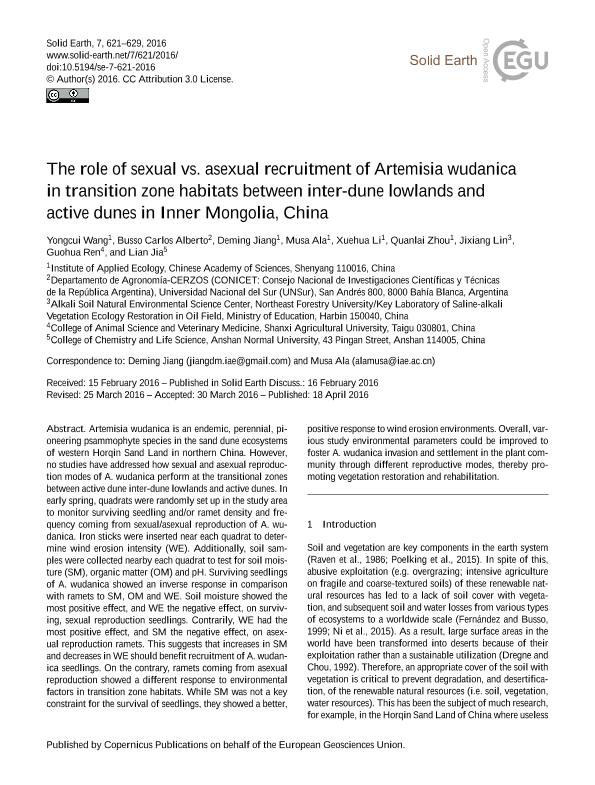Mostrar el registro sencillo del ítem
dc.contributor.author
Wang, Yongcui
dc.contributor.author
Busso, Carlos Alberto

dc.contributor.author
Jiang, Deming
dc.contributor.author
Ala, Musa
dc.contributor.author
Li, Xuehua
dc.contributor.author
Zhou, Quanlai
dc.contributor.author
Lin, Jixiang
dc.contributor.author
Ren, Guohua
dc.contributor.author
Jia, Lian
dc.date.available
2017-07-05T13:53:05Z
dc.date.issued
2016-04
dc.identifier.citation
Wang, Yongcui; Busso, Carlos Alberto; Jiang, Deming; Ala, Musa; Li, Xuehua; et al.; The role of sexual versus asexual recruitment of Artemisia wudanica in transition zone habitats between interdune lowlands and active dunes in Inner Mongolia, China; Copernicus GmbH; Solid Earth; 7; 2; 4-2016; 621-629
dc.identifier.issn
1869-9510 / 1869-9529
dc.identifier.uri
http://hdl.handle.net/11336/19569
dc.description.abstract
Artemisia wudanica is an endemic, perennial pioneering psammophyte species in the sand dune ecosystems of western Horqin Sand Land in northern China. However, no studies have addressed how sexual and asexual reproduction modes of A. wudanica perform at the transitional zones between active dune inter-dune lowlands and active dunes. In early spring, quadrats were randomly set up in the study area to monitor surviving seedling and/or ramet density and frequency coming from sexual/asexual reproduction of A. wudanica. Iron sticks were inserted near each quadrat to determine wind erosion intensity (WE). Additionally, soil samples were collected nearby each quadrat to test for soil moisture (SM), organic matter (OM) and pH. Surviving seedlings of A. wudanica showed an inverse response in 15 comparison with ramets to SM, OM and WE. Soil moisture showed the most positive effect, and WE the negative effect, on surviving, sexual reproduction seedlings. Contrarily, WE had the most positive effect, and SM the negative effect, on asexual reproduction ramets. This suggests that increases in SM and decreases in WE should benefit recruitment of A. wudanica seedlings. On the contrary, ramets coming from asexual reproduction showed a different response to environmental factors in transition zone habitats. While SM was not a key constraint for the survival of seedlings, they showed a better, positive response to wind erosion environments. Overall, various study environmental parameters could be improved to foster A. wudanica invasion and settlement in the plant community through different reproductive modes, thereby promoting vegetation restoration and rehabilitation.
dc.format
application/pdf
dc.language.iso
eng
dc.publisher
Copernicus GmbH
dc.rights
info:eu-repo/semantics/openAccess
dc.rights.uri
https://creativecommons.org/licenses/by/2.5/ar/
dc.subject
Reproduction
dc.subject
Sand Dunes
dc.subject
Sexual
dc.subject
Asexual
dc.subject.classification
Ecología

dc.subject.classification
Ciencias Biológicas

dc.subject.classification
CIENCIAS NATURALES Y EXACTAS

dc.title
The role of sexual versus asexual recruitment of Artemisia wudanica in transition zone habitats between interdune lowlands and active dunes in Inner Mongolia, China
dc.type
info:eu-repo/semantics/article
dc.type
info:ar-repo/semantics/artículo
dc.type
info:eu-repo/semantics/publishedVersion
dc.date.updated
2017-07-03T14:51:52Z
dc.identifier.eissn
1869-9529
dc.journal.volume
7
dc.journal.number
2
dc.journal.pagination
621-629
dc.journal.pais
Alemania

dc.journal.ciudad
Gotinga
dc.description.fil
Fil: Wang, Yongcui. Institute Of Applied Ecology, Shenyang, China;
dc.description.fil
Fil: Busso, Carlos Alberto. Consejo Nacional de Investigaciones Científicas y Técnicas. Centro Científico Tecnológico Conicet - Bahía Blanca. Centro de Recursos Naturales Renovables de la Zona Semiarida. Universidad Nacional del Sur. Centro de Recursos Naturales Renovables de la Zona Semiarida; Argentina. Universidad Nacional del Sur. Departamento de Agronomía; Argentina
dc.description.fil
Fil: Jiang, Deming. Institute Of Applied Ecology, Cas, Shenyang, China;
dc.description.fil
Fil: Ala, Musa. Institute Of Applied Ecology, Shenyang, China;
dc.description.fil
Fil: Li, Xuehua. Institute Of Applied Ecology, Cas, Shenyang, China;
dc.description.fil
Fil: Zhou, Quanlai. Institute Of Applied Ecology, Cas, Shenyang, China;
dc.description.fil
Fil: Lin, Jixiang. Alkali Soil Natural Environmental Science Center, Northeast Forestry University/Key Laboratory of Saline-alkali Vegetation Ecology Restoration in Oil Field, Ministry of Education; China
dc.description.fil
Fil: Ren, Guohua. College of Animal Science and Veterinary Medicine, Shanxi Agricultural University; China
dc.description.fil
Fil: Jia, Lian. College of Chemistry and Life Science, Anshan Normal University; China
dc.journal.title
Solid Earth
dc.relation.alternativeid
info:eu-repo/semantics/altIdentifier/doi/http://dx.doi.org/10.5194/se-7-621-2016
dc.relation.alternativeid
info:eu-repo/semantics/altIdentifier/url/http://www.solid-earth.net/7/621/2016/
Archivos asociados
